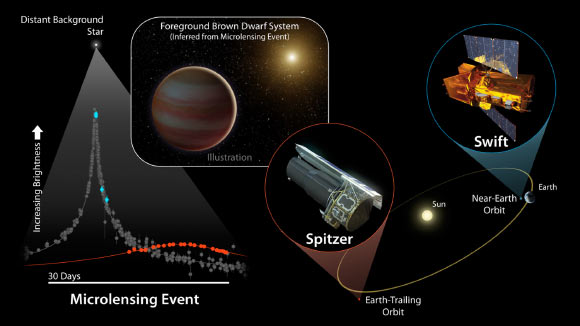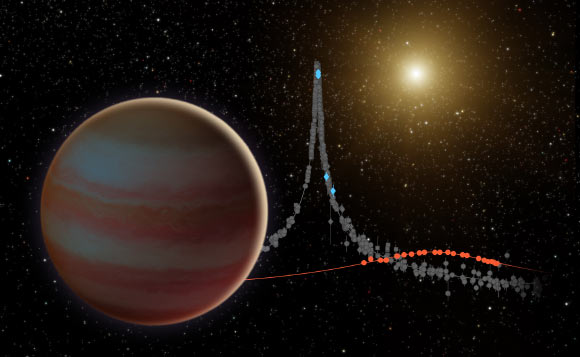A multinational team of astronomers has spotted a brown dwarf orbiting a K-type dwarf star approximately 16,300 light-years away. The object was discovered using a technique called gravitational microlensing, and the help of NASA’s Spitzer and Swift space telescopes.
Brown dwarfs are too big to be considered as planets; yet they do not have sufficient material to fuse hydrogen in their cores to fully develop into stars.
Sometimes described as failed stars, they are midway in mass between stars, like our Sun, and giant planets, like Jupiter and Saturn.
Curiously, astronomers have found that, for stars roughly the mass of our Sun, less than 1 percent have a brown dwarf orbiting within 3 astronomical units (AU). This phenomenon is called the ‘brown dwarf desert.’
The newfound brown dwarf may inhabit this desert.
“We want to understand how brown dwarfs form around stars, and why there is a gap in where they are found relative to their host stars,” said team member Dr. Yossi Shvartzvald, from NASA’s Jet Propulsion Laboratory.
“It’s possible that the ‘brown dwarf desert’ is not as dry as we think.”

NASA’s Spitzer and Swift space telescopes teamed up with ground-based observatories to observe the microlensing event OGLE-2015-BLG-1319. Image credit: NASA / JPL-Caltech.
This brown dwarf was discovered when it and its star passed between Earth and a much more distant star in our Milky Way Galaxy. This created a microlensing event, called OGLE-2015-BLG-1319.
By combining data from these space-based and ground-based telescopes, Dr. Shvartzvald and co-authors determined that the brown dwarf is between 30 and 65 Jupiter masses.
They found two possible distances between the object and its host star, based on available data: 0.25 AU and 45 AU. The 0.25 AU distance would put this system in the brown dwarf desert.
“In the future, we hope to have more observations of microlensing events from multiple viewing perspectives, allowing us to probe further the characteristics of brown dwarfs and planetary systems,” said team member Dr. Geoffrey Bryden, also from NASA’s Jet Propulsion Laboratory.
Details of the research were recently published in the Astrophysical Journal (arXiv.org preprint).
_____
Y. Shvartzvald et al. 2016. First simultaneous microlensing observations by two space telescopes: Spitzer & Swift reveal a brown dwarf in event OGLE-2015-BLG-1319. ApJ 831, 183; doi: 10.3847/0004-637X/831/2/183
This article is based on a press-release issued by NASA.








